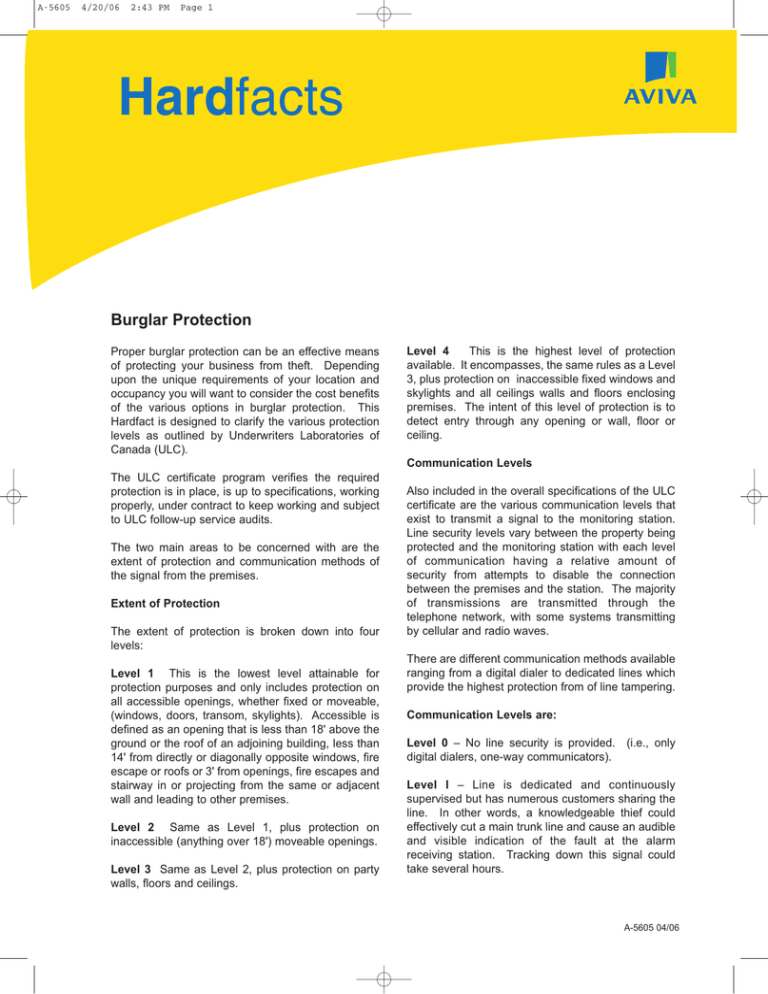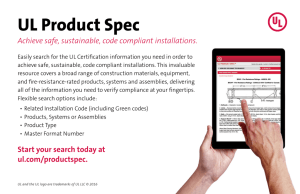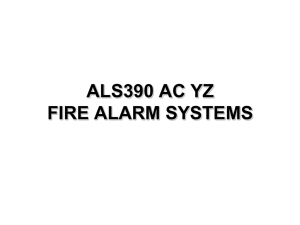
A-5605
4/20/06
2:43 PM
Page 1
Hardfacts
Burglar Protection
Proper burglar protection can be an effective means
of protecting your business from theft. Depending
upon the unique requirements of your location and
occupancy you will want to consider the cost benefits
of the various options in burglar protection. This
Hardfact is designed to clarify the various protection
levels as outlined by Underwriters Laboratories of
Canada (ULC).
The ULC certificate program verifies the required
protection is in place, is up to specifications, working
properly, under contract to keep working and subject
to ULC follow-up service audits.
The two main areas to be concerned with are the
extent of protection and communication methods of
the signal from the premises.
Extent of Protection
The extent of protection is broken down into four
levels:
Level 1 This is the lowest level attainable for
protection purposes and only includes protection on
all accessible openings, whether fixed or moveable,
(windows, doors, transom, skylights). Accessible is
defined as an opening that is less than 18' above the
ground or the roof of an adjoining building, less than
14' from directly or diagonally opposite windows, fire
escape or roofs or 3' from openings, fire escapes and
stairway in or projecting from the same or adjacent
wall and leading to other premises.
Level 2 Same as Level 1, plus protection on
inaccessible (anything over 18') moveable openings.
Level 3 Same as Level 2, plus protection on party
walls, floors and ceilings.
Level 4
This is the highest level of protection
available. It encompasses, the same rules as a Level
3, plus protection on inaccessible fixed windows and
skylights and all ceilings walls and floors enclosing
premises. The intent of this level of protection is to
detect entry through any opening or wall, floor or
ceiling.
Communication Levels
Also included in the overall specifications of the ULC
certificate are the various communication levels that
exist to transmit a signal to the monitoring station.
Line security levels vary between the property being
protected and the monitoring station with each level
of communication having a relative amount of
security from attempts to disable the connection
between the premises and the station. The majority
of transmissions are transmitted through the
telephone network, with some systems transmitting
by cellular and radio waves.
There are different communication methods available
ranging from a digital dialer to dedicated lines which
provide the highest protection from of line tampering.
Communication Levels are:
Level 0 – No line security is provided. (i.e., only
digital dialers, one-way communicators).
Level I – Line is dedicated and continuously
supervised but has numerous customers sharing the
line. In other words, a knowledgeable thief could
effectively cut a main trunk line and cause an audible
and visible indication of the fault at the alarm
receiving station. Tracking down this signal could
take several hours.
A-5605 04/06
A-5605
4/20/06
2:43 PM
Page 2
Level II – Same as Level I but it must identify which
subscriber is affected. ULC specifies identification of
a simple compromise is detected within 6 minutes.
Level III – Same as Level II but the substitution of
phony data and jamming signals are detected.
Levels IV to VII – These higher levels do exist but
primarily for the protection of financial institutions or
areas with high value concentrations.
Local sirens do not fall into any of the categories
listed above.
Summary
A ULC certificate on an alarm system means the
installation meets the security level specified,
equipment meets ULC requirements and the claims
made by the company have the benefit of third party
verifications by an ongoing ULC audit.
Reference
CAN/ULC-S301-M88 (Standard for Central and
Monitoring Station Burglar Alarm Systems).
The monitoring station levels include the following
classifications.
Central/Monitoring Station:
In the past, Central Stations provided their own in
house guard service to verify alarm signals. Today, a
very small number of companies with this type of
service exist as the industry has migrated towards the
use of third party private guards due to problems with
alarm verification and resulting suspensions from
various police services.
Central Stations still provide monitoring services, as
well as an annual inspection and maintenance but the
guard service is contracted out. In effect, they have
become a Monitoring Station. Due to the use of the
private guard service, a component was needed to
enhance response times and in some cases replace
them to verify that an actual break and enter has
occurred before the police can be dispatched. ULC
has recognized this change in the industry and is
allowing "guard companies" that obtain a ULC listing
toward ULC Burglar Alarm Guard Service Certificates
in conjunction with premises that currently have a
ULC certified alarm installation. The new standard
outlined by ULC is CAN/ULC-S301-M88 (Standard
for Central and Monitoring Station Burglar Alarm
Systems).
Shared Service Monitoring:
These companies provide monitoring only to various
independent alarm company installers. They are not
involved with the maintenance or the installation
aspect of the alarm installer service. As required, a
contracted guard service can also be provided or as
needed.
Hardfacts information sheets are designed to give general information on risk management topics. Readers should take specific advice when
dealing with particular situations. Aviva Insurance Company of Canada accepts no responsibility for action taken as a result of information
contained in this publication. The information in Hardfacts is correct at the date of going to press. Printed and published by Aviva Insurance
Company of Canada, Website: www.avivacanada.com
© Copyright, all rights reserved



